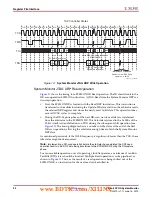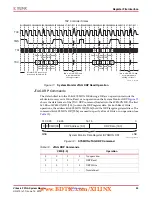
36
Virtex-6 FPGA System Monitor
UG370 (v1.1) June 14, 2010
System Monitor Timing
Event-Driven Sampling
illustrates the event-driven sampling mode. In this operation mode, the
sampling instant and subsequent conversion process are initiated by a trigger signal called
convert start
(CONVST). Event-Driven Sampling mode should only be used with external
analog inputs when precise control over the sampling instant is necessary. The on-chip
sensors and calibration channel should only be monitored in Continuous Sampling mode.
It is not possible to use Event-Driven Sampling when the sequencer is enabled.
Note:
The DCLK must always be present when using Event-Driven Sampling mode. If no DCLK is
present, System Monitor reverts to Continuous mode timing using an internal clock oscillator.
A Low-to-High transition (rising edge) on CONVST or CONVSTCLK defines the exact
sampling instant for the selected analog-input channel. The BUSY signal transitions High
just after the sampling instant on the next rising edge of DCLK. CONVST can be an
asynchronous external signal in which case System Monitor automatically resynchronizes
the conversion process to the ADCCLK.
As with the continuous sampling mode, enough time must be allowed for the acquisition
phase, that is the time between a channel change and the sampling edge (the rising edge of
CONVST or CONVSTCLK, see
). This allows the ADC to acquire
the new signal before it is sampled by the CONVST signal and the conversion phase starts.
The ACQ bit has
no meaning
in event-sampling mode because the sampling instant is
controlled by CONVST/CONVSTCLK. Therefore the acquisition time on a selected
channel is also controlled by the CONVST/CONVSTCLK. CONVST and CONVSTCLK
are logically OR'ed within System Monitor.
If a long acquisition time is required, then the user must leave the required acquisition time
before CONVST/CONVSTCLK is pulsed. After the analog input has been sampled by a
rising edge on CONVST/CONVSTCLK, a conversion is initiated on the
next
rising edge of
ADCCLK. After a conversion has been initiated by CONVST, it is not possible to interrupt
the conversion or start a new conversion until BUSY transitions Low. As with continuous
mode, the configuration registers should be updated before EOC. To register updates after
EOC (for example, switch to continuous mode), a new conversion needs to be initiated by
pulsing CONVST.
After BUSY goes Low, the conversion result is transferred to the output status registers ten
DCLK cycles later, and the EOC logic output pulses High for one DCLK cycle at this time.
If the channel being converted is also being filtered, then the filtered data is only
transferred to the status registers when the last sample result has been converted. Thus, if
a channel is being filtered, no EOC pulse is generated for all but the last conversion result
(such as the 16th, 64th, and 256th sample), depending on the filter setting (see
). An EOC pulse must occur before any new
settings written to the configuration registers are acted on. The EOC, EOS, and
CHANNEL[4:0] outputs operate in the same way as in the continuous-sampling mode,
described previously. If System Monitor is reset while operating in event mode, the first
conversion result is valid on an EOC pulse following the first CONVST pulse after RESET
is released.
www.BDTIC.com/XILINX
















































